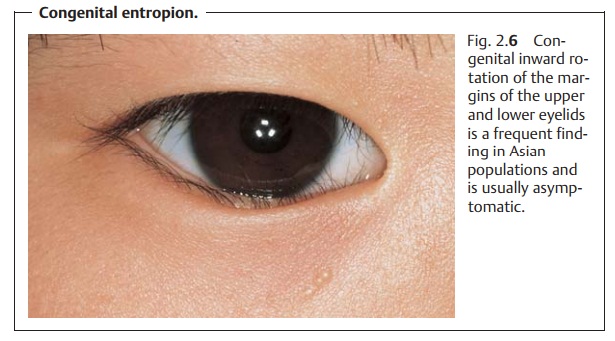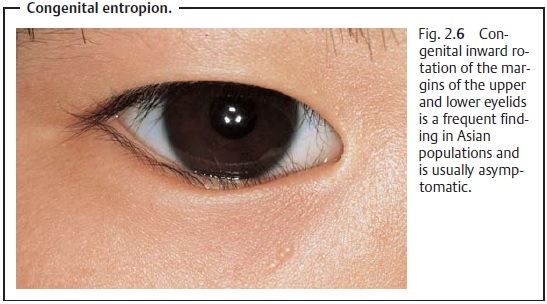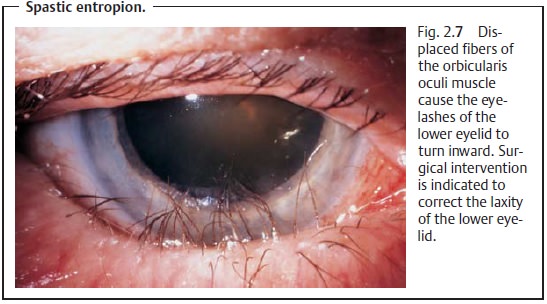Chapter: Ophthalmology: The Eyelids
Entropion

Entropion
Definition
Entropion is characterized by inward rotation
of the eyelid margin. The margin of the eyelid and eyelashes or even the outer
skin of the eyelid are in contact with the globe instead of only the
conjunctiva. The following forms are differ-entiated according to their origin
(see Etiology):
❖Congenital entropion (Fig. 2.6).

❖ Spastic entropion (Fig. 2.7).

❖ Cicatricial entropion.
Epidemiology:
Congenital entropion occurs frequently among Asians but israre
among people of European descent, in whom the spastic and cicatricial forms are
more commonly encountered.
Etiology:
❖Congenital entropion: This results from fleshy thickening of the skin andorbicularis oculi muscle near the margin of the eyelid. Usually the lowereyelid is affected. This condition may persist into adulthood.
❖ Spastic entropion: Thisaffects
only the lower eyelid.A combination ofseveral pathogenetic factors of
varying severity is usually involved:
– The structures supporting the lower eyelid
(palpebral ligaments, tarsus, and eyelid retractor) may become lax with age,
causing the tarsus to tilt inward.
– This causes the fibers of the orbicularis
oculi muscle to override the normally superior margin of the eyelid,
intensifying the blepharospasm resulting from the permanent contact between the
eyelashes and the eyeball.
– Senile enophthalmos, usually occurring in
old age as a result of atrophy of the orbit fatty tissue, further contributes
to instability of the lower eyelid.
❖ Cicatricial entropion: This form of entropion is frequently the
result ofpostinfectious or post-traumatic tarsal contracture (such as trachoma;
burns and chemical injuries). Causes can also include allergic and toxic
reactions (pemphigus, Stevens-Johnson syndrome, and Lyell’s syndrome).
Symptoms and diagnostic considerations (see also etiology):
Constantrubbing of the
eyelashes against the eyeball (trichiasis) represents a per-manent foreign-body
irritation of the conjunctiva which causes a blepharo-spasm that in
turn exacerbates the entropion. The chronically irritated conjunctiva is
reddened, and the eye fills with tears. Only congenital entropion is usually
asymptomatic.
Treatment:
❖ Congenital entropion: To the extent that any treatment is required,
it con-sists of measured, semicircular resection of skin and orbicularis oculi
muscle tissue that can be supplemented by everting sutures where indi-cated.
❖ Spastic entropion: Surgical management must be tailored to the
specificsituation. Usually treatment combines several techniques such as
shorten-ing the eyelid horizontally combined with weakening or diverting the
pre-tarsal fibers of the orbicularis oculi muscle and shortening the skin
verti-cally.
❖ Cicatricial entropion: The surgical management of this form is
identical tothat of spastic entropion.
An adhesive bandage may be applied to increase
tension on the eyelid for temporary relief of symptoms prior to surgery.
Prognosis and complications:
Congenital entropion is usually asymptomatic
and often resolves within the first few months of life.
❖ Spastic entropion: The prognosis is favorable with prompt
surgical inter-vention, although the disorder may recur. Left untreated,
spastic entropion entails a risk of damage to the corneal epithelium with
superin-fection which may progress to the complete clinical syndrome of a
serpigi-nous corneal ulcer.
❖ Cicatricial entropion: The prognosis is favorable with prompt
surgicalintervention (i.e., before any corneal changes occur).
Related Topics